Thank you everybody for joining this webinar. Bea, Nats and Matrin for your help, support and moderating. I hope it was useful for colleagues. On my blog, you will find more resources that could help you on your doctoral journey including my viva preparation. Let me know if you need anything else.
Two ideas that emerged through the webinar…
A list of alumni on the GOGN website with the methodologies we used in our studies may help colleagues to identify who could help them with their study but also help other individuals consider us for supervision and/or external examining. A similar list with our areas of interest, may also be useful for the same reasons.
I used the same title for a recent GOGN webinar (announcement here) and before I actually put together the presentation for this I wrote the following post related to this as my thinking was focusing on this. It all happened over a few days on my train journeys to work when my head was still fresh.
The abstract I had submitted is the following:
In this webinar Chrissi will share with us her doctoral research milestones, the discoveries she made along the way in the area of cross-institutional academic development and collaborative open learning and where these are leading her now in the world of academic development and supporting colleagues developing in the open. Phenomenography, is a methodology developed especially for higher education research. It is a methodology that calls for action. It was the methodology used in this study. Where are the tensions and the opportunities for institutions, academic developers, academics and students? Join Chrissi in this webinar, to discuss and debate. You are all warmly invited.
I will add a link to the webinar recording here.
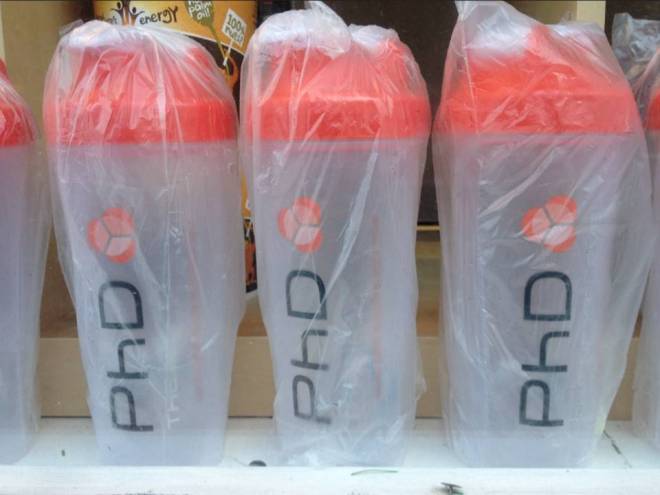
Caption… Warning! A PhD doesn’t come in a bottle… what you see is an optical illusion…
A PhD is a complex and complicated adventure through which we make new discoveries about the world around us, other people but also about ourselves. At the time and for a long time we will feel confused, disappointed, disheartened, alone but also excited and without eureka moments and self-belief we wouldn’t reach the end line. This is how it was for me at least. But what we also need on this wild rollercoaster ride is companions….
Mantai (2017, online) was right when she wrote “It is no secret that it takes a village to raise a PhD graduate”. A supervisory team will never be enough to support a PhD student. Further connections, peers and mentors play a vital role in the doctoral student experience. In my case my critical friends were my peers from the Graduate OER Global Network (GOGN) and a few close colleagues at work. Of course my family supported me too. They all saw the struggles, the frustration. They lived them with me, through me. They also were there to share the good moments, happy times and the success when it was finally arrived. So Matai (2017) is definitely right! A village is needed, if not a town…
I did my PhD at Edinburgh Napier University and my final supervisory team were Dr Sandra Cairncross and Prof. Keith Smyth. The seed for my doctoral studies was formed through course work projects I did during my MSc in Blended and Open Education at the same institution. The MoRE project and the dissertation that followed in which I created an online course and brought PgCert in Academic Practice/Higher Education students from different parts and higher education institutions of the UK together to learn about assessment and feedback using problem-based learning in facilitated groups. In that study I explored the learner experience using phenomenography. That was my very first experience of using phenomenography and an initiative developed and offered in 2010, that brought together PgCert students studying on different programmes together in distributed facilitated groups. Some research linked to that early work, and also work done during my doctoral studies, around cross-institutional collaboration in the area of academic development, which I have initiated and then developed with colleagues, has been shared through the following publications:
- Nerantzi, C. (2011) ‘Not too much facilitation going on’ – Issues in facilitating Online Problem-Based Learning in Academic Development, in: Celebrating the Past and Embracing the Future: Evolution and Innovation in Problem-Based Learning Conference, 30 and 31 March 2011, University of Central Lancashire, pp. 111-124.
- Nerantzi, C. (2011) Freeing Education within and beyond Academic Development, in: Greeener, S. and Rospigliosi, A. (eds.) Proceedings of the 10th European Conference on e-Learning, Brighton Business School, University of Brighton, 10-11 November, pp. 558-566, ECEL2011
- Nerantzi, C. (2012) A case of problem-based learning for cross-institutional collaboration, Special European Conference in E-Learning, Brighton 11, Volume 10, Issue 3, Special Issue EJEL, The electronic Journal of e-Learning (EJEL), pp. 306-314, available at http://www.ejel.org/issue/current.html
- Nerantzi, C. (2014) A personal journey of discoveries through a DIY open course development for professional development of teachers in Higher Education (invited paper), Journal of Pedagogic Development, University of Bedfordshire, Volume 4, Issue 2, pp. 42-58 http://www.beds.ac.uk/jpd
- Nerantzi, C. (2015) Who says academics don’t do CPD? Connecting practitioners and developing together through distributed cross-institutional collaborative CPD in the open, in: Rennie, F. (ed.) The distributed university, JPAAP Special Issue, Volume 3, Issue 1, pp.98-108, available at http://jpaap.napier.ac.uk/index.php/JPAAP/article/view/136
- Nerantzi, C. & Gossman, P. (2015) Towards collaboration as learning. An evaluation of an open CPD opportunity for HE teachers, in: Research in Learning Technology Journal, volume 23, available http://www.researchinlearningtechnology.net/index.php/rlt/article/view/26967
- Nerantzi, C. (2017) Quality teaching through openness and collaboration – an alternative to the TEF?, Special Edition: Teaching Excellence Framework, in: Compass: Journal of Learning and Teaching, Vol. 10, No.2, Greenwich: University of Greenwich, available at https://journals.gre.ac.uk/index.php/compass/article/view/485
Further related publications can be found here. Then one idea brought the other and I soon realised that open academic development courses can be sustained if developed and organised in collaboration with colleagues from other institutions, therefore being informal cross-institutional collaborations and presenting and alternative model for offering academic CPD.
And this is what happened. The module Flexible, Distance and Online Learning, a module I created for our PGCAP at the University of Salford, also became an open cross-institutional course that was organised with Lars Uhlin at the Karolinska Institute using Problem-Based Learning. FDOL was offered for the first time in 2013. One of its iterations became one of my case studies for my doctoral research. The course team split in 2014 and two new courses emerged through this that are still active today, Open Networked Learning (ONL) and Flexible, Open and Social Learning (FOS). The second case study became a course I developed in 2015, Creativity for Learning (#creativeHE) again with collaborative learning features but not predefined or fixed in advance… The course became almost immediately an open course and an open community and was part our our MA in Higher Education at Manchester Met where I moved to during my studies.
As part of my study I reviewed a large number of pedagogical frameworks and models that had collaborative learning features. There was a mix of conceptual and empirical ones that were proposed using digital technologies and used in a range of settings including face-to-face, blended, fully online and in the open. The analysis showed that there were four common characteristics: facilitator support, activities, choice and community (Nerantzi, 2017).
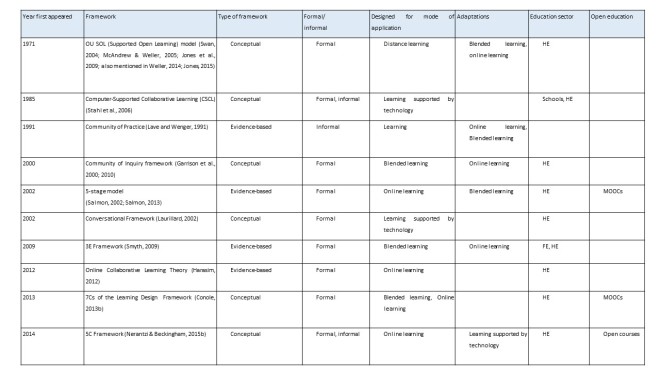
Design frameworks and models reviewed with collaborative learning features and supported by digital technologies (2017)
One of the key output of my studies is an openly licensed collaborative open learning framework. I added this below.
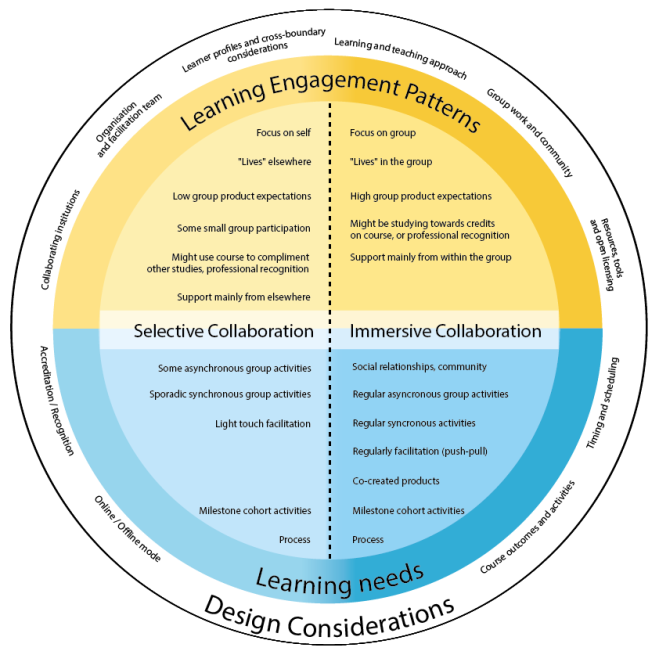
Cross-boundary collaborative open learning framework (Nerantzi, 2017)
The framework synthesizes the phenomenographic findings, the categories of description, the outcome space together with a critical discussion of the literature. It’s three dimensions: engagement patterns, learning needs and design characterises help the course designer and facilitator in creating learning opportunities that are responsive and flexible. It is a cross-boundary collaborative learning framework, you may have noticed. Boundary crossing as defined in this study has four dimensions (Nerantzi, 2017):
- Cross-boundary learning through modes of participation
- Cross-boundary learning through time, places and space
- Cross-boundary learning through culture and language
- Cross-boundary learning through diverse professional contexts
I hope course designers will consider the collaborative open learning framework, when they (re-)consider their collaborative learning strategies. The thesis is in full available online (see references). I have been writing up specific sections from the thesis to publish them in peer reviewed journals. I have to admit that I found it hard to get back into something I feel has come to an end when I did my last corrections and submitted the thesis to the library.
Shortly after completing my doctoral studies I was selected to be an UNESCO co-mentor with Naomi Wahls, also a GOGN member, on an exciting open education project in Uzbekistan in which we reviewed together the current re-accreditation programme for academics who teach modern foreign languages at Uzbek universities. The process was fascinating and we all learnt a lot. Based on our collaboration, the mentors proposal we put together and my doctoral study, I have started constructing an open learning framework with a focus on engagement that incorporates the collaborative learning dimensions. I am adding it below as it stands at the moment and I will be refining this and writing this up in more detail.
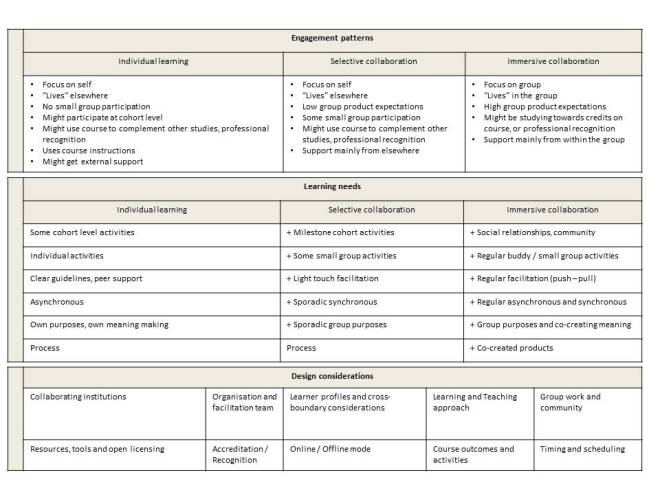
Open Learning Framework (Nerantzi, 2018)
Now, what I think is interesting for me as an academic developer, at a time of turbulence and competitiveness, at least in the UK but also more widely, is that academics in these open cross-institutional courses come together with others from different disciplines, countries and sectors, to share practices. Academics do engage in development activities driven by their own interest to enhance their students’ learning experience. Academics see their development as vital to enhance student learning but they want to be in the driving seat and not be told what to do. Who does… and this is why professional relationships of equals based on trust can make a real difference. When academic development collaborates with faculties and departments as equals, as colleagues, when it is not seen as “the soft arm of management” (Di Napoli, 2014, 5) and academic developers work with academics in networks and communities, the approach is seen as more democratic and more effective (Neame, 2011; Neame, 2013). My research shows this too. Democratic is often mentioned in the findings… Crawford (2009) found that academics seem to prefer external, in her case disciplinary networks and communities after they have completed their internal development linked to their teaching, typically a PgCert, to meet their contractual requirements. There they find fertile ground to grow their teaching and supporting student practice. Today the plethora of open practices creates alternative opportunities for academics for engagement driven by their own interests and aspirations. More than ever before. My own research in this area confirms that not only cross-disciplinary or even cross-institutional but especially cross-boundary approaches to professional development, networks and communities that foster open collaboration act as motivators for engagement in such activities. It will be important for institutions to acknowledge this and provide the freedom, space and resources to academics to enable, support, foster and recognise the value of such development opportunities for their staff through academic development in collaboration with academics in the faculties, students and the public. The recent TLCglobal, an idea by Associate Professor Dr David Smith, Head of School of Education at Charles Sturt University, started in 2017/18, brought together a small group of academics from ManchesterMet in the UK and Charles Sturt University in Australia for peer-to-peer support of practice. Preliminary findings indicate that trust relationships among these academic peers developed rapidly despite or maybe even thanks to the physical and institutional distance and disciplinary and cultural otherness.
Earlier this year, I completed a postgraduate module on Research supervision and the MA in Coaching and Mentoring (pending the marking of my dissertation). I am looking forward to continue mentoring doctoral students through GOGN and can’t wait to get my first doctoral student. Could this be you?
Wishing all my GOGN buddies all the best on their journey and reach out when/if you need help.

References
Crawford, K. (2009). Continuing professional development in higher education: Voices from below. University of Lincoln. [EdD thesis]. Retrieved from http://eprints.lincoln.ac.uk/2146/1/Crawford-Ed%28D%29Thesis-CPDinHE-FINAL%28Sept09%29.pdf
Di Napoli, R. (2014). Value gaming and political ontology: between resistance and compliance in academic development. International journal for academic development, 19 (1), 2014, pp.4-11.
Mantai, L. (2017). Pracamedics, teaching during the PhD, 3 October 2017, Teche Maquarie University’s Learning and Teaching blog. Retrieved from http://teche.ltc.mq.edu.au/pracademics-teaching-phd/
Nerantzi, C. (2017). Towards a framework for cross-boundary collaborative open learning for cross-institutional academic development. PhD thesis, Edinburgh: Edinburgh Napier University. Retrieved from https://www.napier.ac.uk/~/media/worktribe/output-1025583/towards-a-framework-for-cross-boundary-collaborative-open-learning-for.pdf
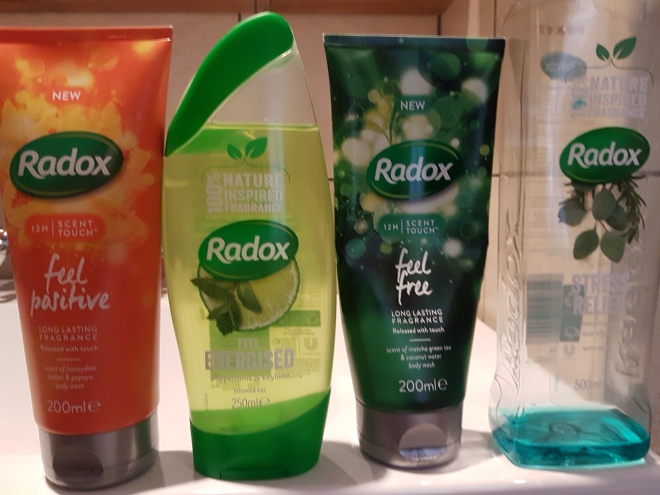
I think Radox has worked out what doctoral students and academics want and need! Feel positive > feel energised > feel free > Stress relief, if everything else fails…



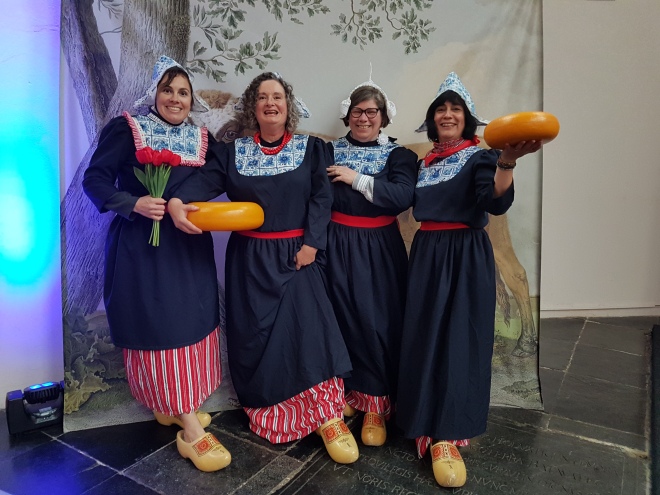






You must be logged in to post a comment.